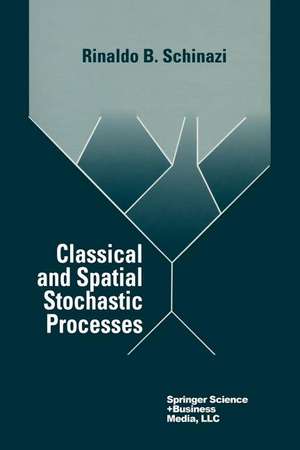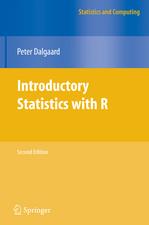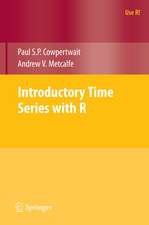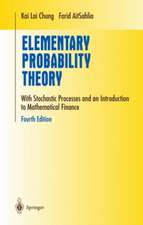Classical and Spatial Stochastic Processes
Autor Rinaldo B. Schinazien Limba Engleză Paperback – 9 oct 2012
| Toate formatele și edițiile | Preț | Express |
|---|---|---|
| Paperback (2) | 382.36 lei 6-8 săpt. | |
| Birkhäuser Boston – 9 oct 2012 | 382.36 lei 6-8 săpt. | |
| Springer – 29 sep 2014 | 453.78 lei 6-8 săpt. | |
| Hardback (1) | 533.06 lei 3-5 săpt. | |
| Springer – 29 sep 2014 | 533.06 lei 3-5 săpt. |
Preț: 382.36 lei
Nou
Puncte Express: 574
Preț estimativ în valută:
73.17€ • 78.24$ • 61.00£
73.17€ • 78.24$ • 61.00£
Carte tipărită la comandă
Livrare economică 18 aprilie-02 mai
Preluare comenzi: 021 569.72.76
Specificații
ISBN-13: 9781461272038
ISBN-10: 1461272033
Pagini: 196
Ilustrații: XI, 179 p.
Dimensiuni: 155 x 235 x 10 mm
Greutate: 0.28 kg
Ediția:Softcover reprint of the original 1st ed. 1999
Editura: Birkhäuser Boston
Colecția Birkhäuser
Locul publicării:Boston, MA, United States
ISBN-10: 1461272033
Pagini: 196
Ilustrații: XI, 179 p.
Dimensiuni: 155 x 235 x 10 mm
Greutate: 0.28 kg
Ediția:Softcover reprint of the original 1st ed. 1999
Editura: Birkhäuser Boston
Colecția Birkhäuser
Locul publicării:Boston, MA, United States
Public țintă
ResearchCuprins
I Discrete Time Markov Chains.- I.1 Three fundamental examples.- I.2 Classification of states.- I.3 Finite Markov chains.- I.4 Birth and death chains.- I.5 An example of coupling.- I.6 Time to get ruined.- I.7 Absorption probabilities for martingales.- I.8 Random walks.- I.9 The Bienaymé-Galton-Watson branching process.- I.10 Proof of Theorem I.2.1.- I.11 Proof of Theorem I.2.2.- I.12 Proof of Theorem I.9.1.- II Stationary Distributions of a Markov Chain.- II. 1 Existence of stationary distributions.- II.2 Reversible measures.- II.3 Convergence to a stationary distribution.- II.4 The finite case.- II.5 Proof of Proposition II. 1.2.- II.6 Proof of Proposition II. 1.3.- II.7 Proofs of Theorems II.3.1 and II.4.2.- III Continuous Time Birth and Death Markov Chains.- III.1 The exponential distribution.- III.2 Construction and first properties.- III.3 Limiting probabilities.- III.4 Classification of states.- III.5 The Poisson process.- III.6 Passage times.- III.7 A queue which is not Markovian.- III.8 Proof of Theorem III.3.1.- III.9 Proof of Theorem III.5.1.- III.10 Proof of Theorem III.5.2.- IV Percolation.- IV.1 Percolation on Zd.- IV.2 Further properties of percolation on Zd.- IV.3 Percolation on a tree and two critical exponents.- V A Cellular Automaton.- V.1 The model.- V.2 A renormalization argument.- VI Continuous Time Branching Random Walk.- VI.1 A continuous time Bienayme-Galton-Watson process.- VI.2 A continuous time branching random walk.- VI.3 The first phase transition is continuous.- VI.4 The second phase transition is discontinuous.- VI.5 Proof of Theorem VI.2.1.- VII The Contact Process on a Homogeneous Tree.- VII.1 The two phase transitions.- VII.2 Characterization of the first phase transition.- VII.3 The graphical construction.- VII.4 Proofs.- VII.5 Openproblems.- Appendix: Some Facts About Probabilities on Countable Spaces.- 1 Probability space.- 2 Independence.- 3 Discrete random variables.- References.
Recenzii
"An appetizing textbook for a first course in stochastic processes. It guides the reader in a very clever manner from classical ideas to some of the most interesting modern results… All essential facts are presented with clear proofs, illustrated by beautiful examples… The book is well organized, has informative chapter summaries, and presents interesting exercises. The clear proofs are concentrated at the ends of the chapters making it easy to find the results. The style is a good balance of mathematical rigorosity and user-friendly explanation." —Biometric Journal
"This small book is well-written and well-organized...Only simple results are treated...but at the same time many ideas needed for more complicated cases are hidden and in fact very close. The second part is a really elementary introduction to the area of spatial processes...All sections are easily readable and it is rather tentative for the reviewer to learn them more deeply by organizing a course based on this book. The reader can be really surprised seeing how simple the lectures on these complicated topics can be. At the same time such important questions as phase transitions and their properties for some models and the estimates for certain critical values are discussed rigorously...This is indeed a first course on stochastic processes and also a masterful introduction to some modern chapters of the theory." —Zentralblatt Math.
"This small book is well-written and well-organized...Only simple results are treated...but at the same time many ideas needed for more complicated cases are hidden and in fact very close. The second part is a really elementary introduction to the area of spatial processes...All sections are easily readable and it is rather tentative for the reviewer to learn them more deeply by organizing a course based on this book. The reader can be really surprised seeing how simple the lectures on these complicated topics can be. At the same time such important questions as phase transitions and their properties for some models and the estimates for certain critical values are discussed rigorously...This is indeed a first course on stochastic processes and also a masterful introduction to some modern chapters of the theory." —Zentralblatt Math.
Notă biografică
Rinaldo Schinazi is a Professor of Mathematics at the University of Colorado.
Textul de pe ultima copertă
The revised and expanded edition of this textbook presents the concepts and applications of random processes with the same illuminating simplicity as its first edition, but with the notable addition of substantial modern material on biological modeling. While still treating many important problems in fields such as engineering and mathematical physics, the book also focuses on the highly relevant topics of cancerous mutations, influenza evolution, drug resistance, and immune response. The models used elegantly apply various classical stochastic models presented earlier in the text, and exercises are included throughout to reinforce essential concepts.
The second edition of Classical and Spatial Stochastic Processes is suitable as a textbook for courses in stochastic processes at the advanced-undergraduate and graduate levels, or as a self-study resource for researchers and practitioners in mathematics, engineering, physics, and mathematical biology.
Reviews of the first edition:
An appetizing textbook for a first course in stochastic processes. It guides the reader in a very clever manner from classical ideas to some of the most interesting modern results. … All essential facts are presented with clear proofs, illustrated by beautiful examples. … The book is well organized, has informative chapter summaries, and presents interesting exercises. The clear proofs are concentrated at the ends of the chapters making it easy to find the results. The style is a good balance of mathematical rigorosity and user-friendly explanation. —Biometric Journal
This small book is well-written and well-organized. ... Only simple results are treated ... but at the same time many ideas needed for more complicated cases are hidden and in fact very close. The second part is a really elementary introduction to the area of spatial processes. ... All sections are easily readable and it is rather tentative for the reviewerto learn them more deeply by organizing a course based on this book. The reader can be really surprised seeing how simple the lectures on these complicated topics can be. At the same time such important questions as phase transitions and their properties for some models and the estimates for certain critical values are discussed rigorously. ... This is indeed a first course on stochastic processes and also a masterful introduction to some modern chapters of the theory. —Zentralblatt Math
The second edition of Classical and Spatial Stochastic Processes is suitable as a textbook for courses in stochastic processes at the advanced-undergraduate and graduate levels, or as a self-study resource for researchers and practitioners in mathematics, engineering, physics, and mathematical biology.
Reviews of the first edition:
An appetizing textbook for a first course in stochastic processes. It guides the reader in a very clever manner from classical ideas to some of the most interesting modern results. … All essential facts are presented with clear proofs, illustrated by beautiful examples. … The book is well organized, has informative chapter summaries, and presents interesting exercises. The clear proofs are concentrated at the ends of the chapters making it easy to find the results. The style is a good balance of mathematical rigorosity and user-friendly explanation. —Biometric Journal
This small book is well-written and well-organized. ... Only simple results are treated ... but at the same time many ideas needed for more complicated cases are hidden and in fact very close. The second part is a really elementary introduction to the area of spatial processes. ... All sections are easily readable and it is rather tentative for the reviewerto learn them more deeply by organizing a course based on this book. The reader can be really surprised seeing how simple the lectures on these complicated topics can be. At the same time such important questions as phase transitions and their properties for some models and the estimates for certain critical values are discussed rigorously. ... This is indeed a first course on stochastic processes and also a masterful introduction to some modern chapters of the theory. —Zentralblatt Math
Caracteristici
Enhances and expands on the title's successful first edition Provides an elementary yet very useful treatment of spatial stochastic models, with applications to mathematical biology Includes exercises at the end of chapters to reinforce concepts Relevant to a wide audience of advanced undergraduates, graduate students, and researchers in engineering, physics, and mathematical biology Includes supplementary material: sn.pub/extras
















